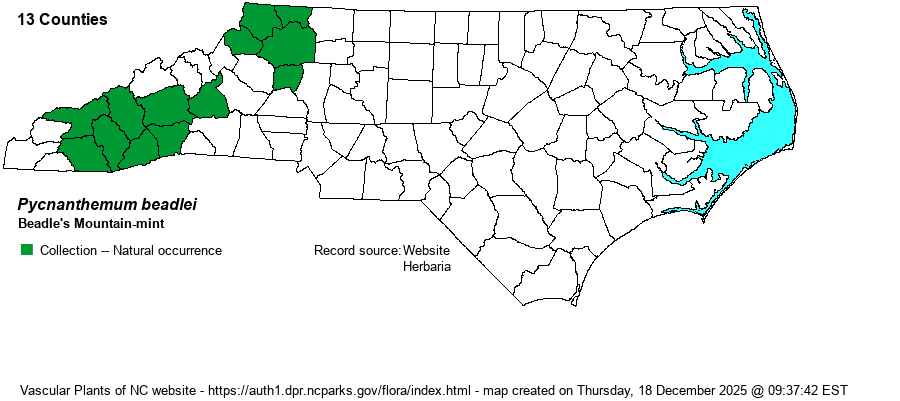| Author | (Small) Fernald | |
| Distribution | Scattered over the Mountains, and might occur in all of them; present in the western Piedmont foothills, at least in the Brushy Mountains. As this is perhaps a hybrid derivative between P. montanum and P. muticum, the range and abundance in the state is not finalized. Thankfully, the SERNEC database does contain many records for it. This species is a Southern Appalachian endemic, ranging from WV south to northwestern SC and northeastern GA.
| |
| Abundance | Weakley's (2024) map shows this species as "uncommon" in the Mountains and "rare" in the Piedmont. The specimens and the county range map may suggest it can be fairly common in parts of the Mountains, and rare in the Brushy Mountains (if not locally more numerous there). | |
| Habitat | This is a montane species, of dry to mesic, open forests, as well as wooded borders. It prefers rocky sites, on moderate to steep slopes. | |
| Phenology | Blooms from August to September, and fruits shortly after flowering. | |
| Identification | This is a rather typical member of the genus, growing to about 3 feet tall, with numerous branches in the upper portions of the stem. It has ovate leaves, 1-1.5 inches wide, and less than 3 times longer than wide; "Leaves of the lower and middle stem with lower surfaces glabrate, glandular-punctate, similar in color to the dark green upper surface; calyx 5-7 mm long" (Weakley 2018). See Weakley (2018) and Wofford (1989) for other information in keys, though the fact that many similar species have the lower and middle stem leaves whitened will separate P. beadlei from some similar ones. Unfortunately, details of the calyx are probably needed to finalize the identification. | |
| Taxonomic Comments | Weakley (2018) says "A tetraploid species (n = 38), probably an allotetraploid derived from P. montanum x muticum."
| |
| Other Common Name(s) | None | |
| State Rank | S3 | |
| Global Rank | G2G3 | |
| State Status | | |
| US Status | | |
| USACE-agcp | | |
| USACE-emp | | |

